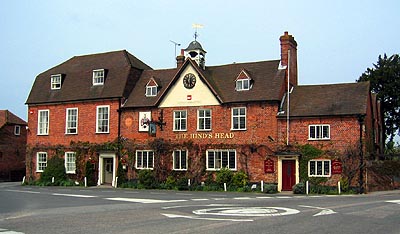 |
 |
|||
|
|
Aldermaston Wharf was the site of a fine Roman Villa, only the bathhouse of which has survived. Unfortunately, it was dug up by archaeologists just over the parish boundary in Beenham. The origin of the village's name is quite obvious if you think about it: 'Alderman's Town'. This was not today's borough official, but the Saxon Ealdorman of Berkshire. This man (the equivalent of an Earl) was the predecessor of the county sheriff, the man who ruled Berkshire on the King's behalf. Though his country estate was here, he would have spent much time at his town-house in the county town of Wallingford. Aldermaston was thus a significant settlement which showed early signs of developing into an important town. Aldermaston Church was a Saxon Minster. The medieval Achard family, who entertained Henry III at the manor (1227), gave the parish church away to Sherborne (ie. Pamber) Priory (Hampshire) and consequently are all buried at Sparsholt. The church does contain a beautiful alabaster effigial monument to one of their successors, Sir George Forster and his wife (1530), and a fine set of hatchments of the Congreve family. Aldermaston Court was the home of these people. Originally, as Aldermaston House, it stood immediately alongside the church. An early house was rebuilt in 1636 by Sir Humphrey Forster. He was a staunch Royalist during the Civil War. This caused the Parliamentary army to station troops in the village to guard the Kennet crossings before the Second Battle of Newbury. Forster's house, unfortunately, burnt down two hundred years later. The place was not completely gutted and the beautiful figured wooden staircase was saved. In 1848, it was reinstalled at the new Court, along with some old stained glass and 15th century chimneys from the original house. It is an interesting place with an imposing tower. The entrance gates to the park were won in a card game from the owner of Midgham House. Immediately opposite, but at the far end of the main street, is the Hinds Head Inn named after the crest of the local lords, the Forster family. This symbol can also be seen in the parish church. The pub has its own gaol-house round the back. Last used in the 1860s, its unfortunate inhabitant apparently burnt to death. The supporters of the 1830 Machine Riots of Western Berkshire marched through Aldermaston and wrecked some twenty-three agricultural machines. Farmers were so frightened, they placed their machinery out in the open to prevent any damage elsewhere. The Falcon, or Fuzz Bush as it was sometimes called, on the edge of Tadley (Hampshire), is actually just in Aldermaston parish. The Aldermaston witch, Maria Hale, whose powers flourished in the 1850s & 60s, was said to turn herself into a large brown hare and sit outside the pub to learn all the local gossip. Once the hare was shot at by the local gamekeeper who wounded it in the leg. Ever after, Maria was seen to have a pronounced limp! Maria was often in trouble with the police for conning the gullible with her curses and cures. In the village, however, she was greatly feared and people were terrified of crossing her. One day she demanded that the village shopkeeper buy some bacon off her. He was taken to her home, Park Cottage on the edge of the Park, where she produced two handsome flitches from beneath the bed. Never before had such ham tasted in Aldermaston - but Maria kept no pigs! She was in the habit of leaning over her neighbour's fences and asking for flowers. If she was refused, the plants would wither and die. The same fate she had inflicted on her own daughter who and she later bewitched her son when he wished to leave home and work in Windsor. He soon became ill and had to return home. Maria died in 1879 at the age of eighty-eight and was buried beneath the yew tree to the right of the path by the church tower. The coffin was rammed down with stones and bricks and the diggers jumped up and down on her to ensure she would never rise again. Placing an extra stone on her grave was, for many years, a popular pastime in the Aldermaston. Though it is said that if you place a pin in the church door and race around the building three times her ghost will appear. Aldermaston is one of only eleven places, left in the country, that still holds a Candle Auction. Once common, these rare affairs are controlled by a tallow candle in Aldermaston Parish Hall. A pin is placed an inch from the flame and bidding continues until the pin falls. The last to bid secures the lot. In Aldermaston's case this will be the three year lease of a field called Church Acre. |
|||
| © Nash Ford Publishing 2001. All Rights Reserved. | ||||



 Aldermaston
Aldermaston